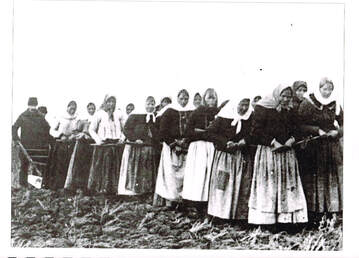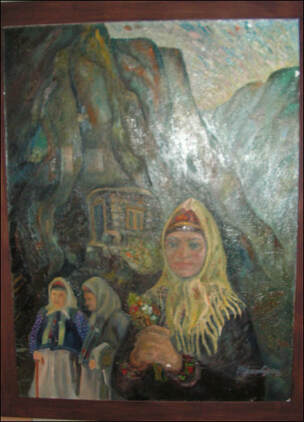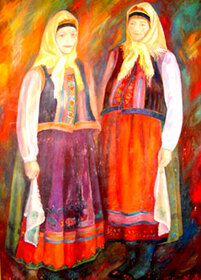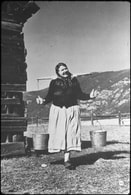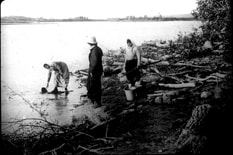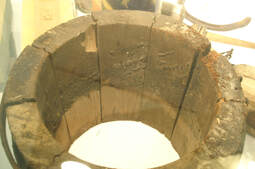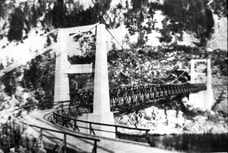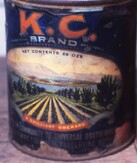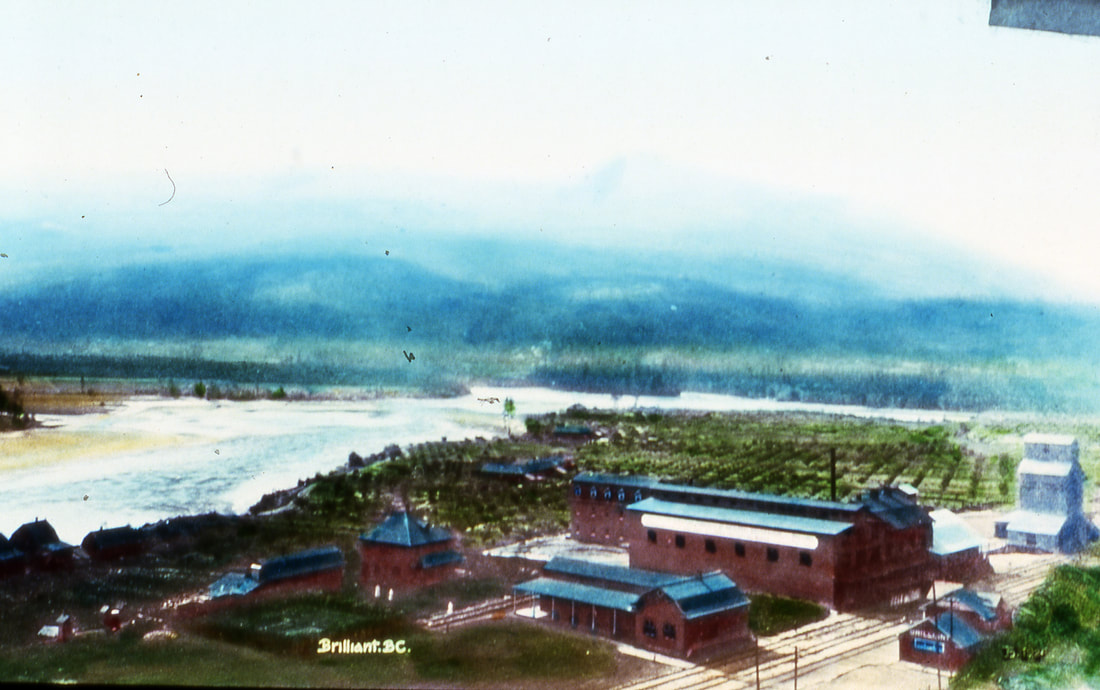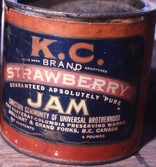THIS CHAPTER FEATURES
DOUKHOBORS & CONJECTURES
DOUKHOBORS & CONJECTURES
DOUKHOBORS &
LUKERIA'S PROPHECY
Lukeria's Prophecy
In my Doukhobor studies, I have often wondered about Lukeria Kalmykova’s prophecy: ‘In the future Doukhobors will live in glass houses’.
In her time, glass was a luxury, primarily reserved for the wealthy class and churches. [The moody lighting provided by stained glass windows provided a restful and subtle atmosphere that is easy to mistake for spirituality and divine presence. Hitler studied the effect of the Catholic mass in cathedrals on participants in his theoretical experiments on mind control and manipulation].
Lukeria’s prophecy has come to pass - the Doukhobors of today do live in luxury with plenty of glass in luxurious houses. Others have found a home, living spiritually, once again, in organized churchianity surrounded by ornate stained glass.
The glass house prophecy has come to pass.
But the Doukhobors were also well versed in parable and allegory, so I searched for an additional, symbolic meaning in her prophecy, aside from the simple physical interpretation.
After much thought and consideration, it dawned on me.
The prophetic day is now upon us, and the glass house we live in is technological, most simply illustrated by the television screen in every home, and its offspring in every pocket and even on some wrists.
All of our lives are now encapsulated within the content of the T V monitor or computer screen. Our consumer goods, our aspirations, our entertainments, our information, are all contained within the screen. Our life is now expressed and reflected within that glass box; it has indeed become our home. This illusory object which is the ultimate non-reality has now become our reality. To cap it off, we are all now surveilled to such a degree that indeed, we are living in a glass house. The corporate powers know all we see and do. We are all indeed, living in glass houses where all is visible.
Regrettably, her prophecy has come to pass in a profound way and it would take a mighty revolution and re-organisation of our mind set and incredible will power to overcome this enslavement we have been conditioned to accept as normal.
This does not bode well for the future of the world, and just as pacifism and other endearing Doukhobor values whose time has come in order for the world to survive, it is time to strive to recapture those ‘old fashioned’ values into the present day reality of our lives, replacing the conditioned illusion.
A further prophecy said that someday the Doukhobors would return to their homeland.
For many years, the Doukhobors in Canada believed this literally, and were prepared to leave at a moment's notice, another pout. However, there is an allegorical interpretation in this case also.
I believe that returning home will be a spiritual return to the original holistic Doukhobor values; pacifism, holistic life style, harmony with fellow persons and nature.
To me, it is the only safe future for our world.
Hopefully this is still possible and it is not too late for this to also come to pass.
In reverence to our revered forbears, and humanity in general, the Doukhobors today could [and should] lead the way and proselytize by example.
What sane intelligent person can honestly resist such a message?
In my Doukhobor studies, I have often wondered about Lukeria Kalmykova’s prophecy: ‘In the future Doukhobors will live in glass houses’.
In her time, glass was a luxury, primarily reserved for the wealthy class and churches. [The moody lighting provided by stained glass windows provided a restful and subtle atmosphere that is easy to mistake for spirituality and divine presence. Hitler studied the effect of the Catholic mass in cathedrals on participants in his theoretical experiments on mind control and manipulation].
Lukeria’s prophecy has come to pass - the Doukhobors of today do live in luxury with plenty of glass in luxurious houses. Others have found a home, living spiritually, once again, in organized churchianity surrounded by ornate stained glass.
The glass house prophecy has come to pass.
But the Doukhobors were also well versed in parable and allegory, so I searched for an additional, symbolic meaning in her prophecy, aside from the simple physical interpretation.
After much thought and consideration, it dawned on me.
The prophetic day is now upon us, and the glass house we live in is technological, most simply illustrated by the television screen in every home, and its offspring in every pocket and even on some wrists.
All of our lives are now encapsulated within the content of the T V monitor or computer screen. Our consumer goods, our aspirations, our entertainments, our information, are all contained within the screen. Our life is now expressed and reflected within that glass box; it has indeed become our home. This illusory object which is the ultimate non-reality has now become our reality. To cap it off, we are all now surveilled to such a degree that indeed, we are living in a glass house. The corporate powers know all we see and do. We are all indeed, living in glass houses where all is visible.
Regrettably, her prophecy has come to pass in a profound way and it would take a mighty revolution and re-organisation of our mind set and incredible will power to overcome this enslavement we have been conditioned to accept as normal.
This does not bode well for the future of the world, and just as pacifism and other endearing Doukhobor values whose time has come in order for the world to survive, it is time to strive to recapture those ‘old fashioned’ values into the present day reality of our lives, replacing the conditioned illusion.
A further prophecy said that someday the Doukhobors would return to their homeland.
For many years, the Doukhobors in Canada believed this literally, and were prepared to leave at a moment's notice, another pout. However, there is an allegorical interpretation in this case also.
I believe that returning home will be a spiritual return to the original holistic Doukhobor values; pacifism, holistic life style, harmony with fellow persons and nature.
To me, it is the only safe future for our world.
Hopefully this is still possible and it is not too late for this to also come to pass.
In reverence to our revered forbears, and humanity in general, the Doukhobors today could [and should] lead the way and proselytize by example.
What sane intelligent person can honestly resist such a message?
DOUKHOBORS AND HANDKERCHIEFS
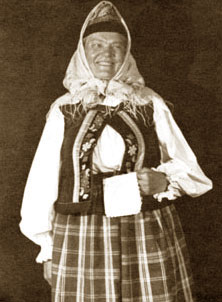 Polly Karnitsky 1906-1992 Photo Kenneth Peacock
Polly Karnitsky 1906-1992 Photo Kenneth Peacock
Various symbolic beliefs have been preserved and continue to this day among the Doukhobors. In some cases the origins of these practices are no longer relevant, and in others, are not even known by today's practitioners. One of these is the significance of the handkerchief as part of the traditional Doukhobor women's costume.
There have been various inquiries lately about the origin of the handkerchiefs Doukhobor women hold when in traditional costume. Aside from functional use of absorbing sniffles or wiping away tears, these handkerchiefs are often examples of ornate handiwork and design, and clearly, are not simply functional. In essence, they have come to embody symbolic significance within the general accouterments.
Although the Doukhobors ostensibly rejected symbolism and ritualistic practice as empty rhetoric of the Orthodox Church, they retained ritual and symbolism of their own dating back many generations, so much so that even contemporary Doukhobors carry out some of these behavioral tactics with no viable connection or understanding of their origin.
Some examples would include the symbolism and origin of Bread, Salt & Water, head coverings worn by Doukhobor women, separation of men and women at prayers and so on. Furthermore, many obscure references of doubtful origin appearing in The Book of Life (Zhivotnia Kniga), which do not seem to have relevance to Doukhobor doctrine could also be included. (Some of these hazy connections are elucidated in S. Inikova's writings which readers would find interesting.)
The following conclusions about the origin of the hanky is based on research and conversations that I have had with Doukhobor elders in Calgary and in Russia.
The origin of the symbolism of the Doukhobor handkerchief seems to find a parallel to the time of the Jews fleeing Pharaoh in historic Egypt. To sustain themselves on their monumental journey (pout) the Jewish women hastily prepared bundles of unleavened bread to sustain them on their journey out of Egypt. This ritual bag of sustenance is noted to this day in the Jewish Seder and the unleavened bread is still eaten on that high holiday to commemorate their historic flight.
Early Doukhobors were very familiar with the Israelite story of emancipation. Psalm 69 in the Book of Life is essentially a rewrite of the Commandments in Chapter 20 in the book of Exodus. Psalm 189 contains the themes in Exodus Chapters 13 to 17. This indicates an early familiarity with the story of the flight.
It is a natural conclusion that the story of the Israelite's deliverance in Exodus in the Bible connected sympathetically with the Doukhobors who related to the history of displacement and exile. It is logical to assume that this became the inspiration for the female elders to have such a survival hanky prepared for a quick move. It would contain the dried bread [soukherii], hard sugar if it was available, and tea, mostly home grown organic. In case of an enforced quick move they were prepared with nourishment for at least a limited time.
I have known of Doukhobors as recent as the days of settlement in B C who had such preparatory bags near by, and on one occasion, due to a false alarm, these bags were gathered and a trek began out of some of the communal villages, until they realized it was a false alarm and not necessary.
This was recounted to me by a Doukhobor elder some time past and occurred in the early years of communal settlement in B C. Other elders were prepared for departure at a moment's notice as they believed that their move, either back to Russia or another destination was imminent.
There was no shortage of hanky material, this would be comprised of linen remnants from larger pieces and in early days were not custom made as handkerchiefs.
As well, such 'lunches' as contained in the handkerchief were often tucked into the skirt waist band and taken to the fields at work. The female attire did not have pockets, so a handy piece of cloth which could be tied into a bundle became essential. (Some readers will recall Granny Soukeroff with her 'hanky-bag' full of various goodies that she could talk about in her comedic sketches.)
Eventually, through permanent settlement with the threat of enforced move removed, these preparations for the 'pout' (journey), were no longer necessary, and gradually, the hankies no longer contained anything but continued to serve a symbolic value, accompanying the female costume, and signifying that flight was possible if necessary. We see a handkerchief, too, customarily placed in the hand of our deceased. At rest, a transmigration occurs, though not in the physical sense.
As this occurred, the handkerchiefs took on a more decorative function and embroidery and fringe crochet and designs etc. were added. rs, but not in the physical,
Today's practitioners may not know the origin of this adornment, but include the hanky as an integral part of the costume. This is only one example of many which at one time arose out of necessity, but have now lost their significance and meaning to the contemporary generation, although the outward form is still preserved in ritual.
There have been various inquiries lately about the origin of the handkerchiefs Doukhobor women hold when in traditional costume. Aside from functional use of absorbing sniffles or wiping away tears, these handkerchiefs are often examples of ornate handiwork and design, and clearly, are not simply functional. In essence, they have come to embody symbolic significance within the general accouterments.
Although the Doukhobors ostensibly rejected symbolism and ritualistic practice as empty rhetoric of the Orthodox Church, they retained ritual and symbolism of their own dating back many generations, so much so that even contemporary Doukhobors carry out some of these behavioral tactics with no viable connection or understanding of their origin.
Some examples would include the symbolism and origin of Bread, Salt & Water, head coverings worn by Doukhobor women, separation of men and women at prayers and so on. Furthermore, many obscure references of doubtful origin appearing in The Book of Life (Zhivotnia Kniga), which do not seem to have relevance to Doukhobor doctrine could also be included. (Some of these hazy connections are elucidated in S. Inikova's writings which readers would find interesting.)
The following conclusions about the origin of the hanky is based on research and conversations that I have had with Doukhobor elders in Calgary and in Russia.
The origin of the symbolism of the Doukhobor handkerchief seems to find a parallel to the time of the Jews fleeing Pharaoh in historic Egypt. To sustain themselves on their monumental journey (pout) the Jewish women hastily prepared bundles of unleavened bread to sustain them on their journey out of Egypt. This ritual bag of sustenance is noted to this day in the Jewish Seder and the unleavened bread is still eaten on that high holiday to commemorate their historic flight.
Early Doukhobors were very familiar with the Israelite story of emancipation. Psalm 69 in the Book of Life is essentially a rewrite of the Commandments in Chapter 20 in the book of Exodus. Psalm 189 contains the themes in Exodus Chapters 13 to 17. This indicates an early familiarity with the story of the flight.
It is a natural conclusion that the story of the Israelite's deliverance in Exodus in the Bible connected sympathetically with the Doukhobors who related to the history of displacement and exile. It is logical to assume that this became the inspiration for the female elders to have such a survival hanky prepared for a quick move. It would contain the dried bread [soukherii], hard sugar if it was available, and tea, mostly home grown organic. In case of an enforced quick move they were prepared with nourishment for at least a limited time.
I have known of Doukhobors as recent as the days of settlement in B C who had such preparatory bags near by, and on one occasion, due to a false alarm, these bags were gathered and a trek began out of some of the communal villages, until they realized it was a false alarm and not necessary.
This was recounted to me by a Doukhobor elder some time past and occurred in the early years of communal settlement in B C. Other elders were prepared for departure at a moment's notice as they believed that their move, either back to Russia or another destination was imminent.
There was no shortage of hanky material, this would be comprised of linen remnants from larger pieces and in early days were not custom made as handkerchiefs.
As well, such 'lunches' as contained in the handkerchief were often tucked into the skirt waist band and taken to the fields at work. The female attire did not have pockets, so a handy piece of cloth which could be tied into a bundle became essential. (Some readers will recall Granny Soukeroff with her 'hanky-bag' full of various goodies that she could talk about in her comedic sketches.)
Eventually, through permanent settlement with the threat of enforced move removed, these preparations for the 'pout' (journey), were no longer necessary, and gradually, the hankies no longer contained anything but continued to serve a symbolic value, accompanying the female costume, and signifying that flight was possible if necessary. We see a handkerchief, too, customarily placed in the hand of our deceased. At rest, a transmigration occurs, though not in the physical sense.
As this occurred, the handkerchiefs took on a more decorative function and embroidery and fringe crochet and designs etc. were added. rs, but not in the physical,
Today's practitioners may not know the origin of this adornment, but include the hanky as an integral part of the costume. This is only one example of many which at one time arose out of necessity, but have now lost their significance and meaning to the contemporary generation, although the outward form is still preserved in ritual.
THE KOOTENAY-COLUMBIA
RIVERS AND THE DOUKHOBORS
One of the enduring symbols of the history of the Doukhobors is that of KC JAM, which stood for Kootenay Columbia Jam and Preserving Works, the jam factories of the Christian Community of Universal Brotherhood. Under this label, which showed an orchard, was the legend: A Brilliant Jam Factory. The name came from the fact that the factory was located at Brilliant, at the confluence of the Kootenay/Columbia Rivers. The name Brilliant came from the Russian word, Brillyant, [Вриллиант] which means approximately the same in both languages, 'sparkling'.
Peter Verigin, as he supervised the first buildings being constructed on the site in 1908, said that the waters of the Columbia sparkled like diamonds, and . . . ‘we will call this settlement Brillyant'.
RIVERS AND THE DOUKHOBORS
One of the enduring symbols of the history of the Doukhobors is that of KC JAM, which stood for Kootenay Columbia Jam and Preserving Works, the jam factories of the Christian Community of Universal Brotherhood. Under this label, which showed an orchard, was the legend: A Brilliant Jam Factory. The name came from the fact that the factory was located at Brilliant, at the confluence of the Kootenay/Columbia Rivers. The name Brilliant came from the Russian word, Brillyant, [Вриллиант] which means approximately the same in both languages, 'sparkling'.
Peter Verigin, as he supervised the first buildings being constructed on the site in 1908, said that the waters of the Columbia sparkled like diamonds, and . . . ‘we will call this settlement Brillyant'.
If this association of the Doukhobors with the Columbia River sounds romantic, it probably was. Coming from the expansive plains of Saskatchewan with occasional potable water problems after their unfortunate land seizure, the Doukhobors embarked on an historic trek by foot, wagon, and finally train and river boat to this new promised land.
Many older pilgrims felt immediately at home because it reminded them of their previous homeland in the Caucasus as it did Peter Verigin. Others, used to the steppes of SK, felt claustrophobic.
Peter Verigin cautioned them not to worry; ' . . . these mountains and trees are our friends and they will provide our new homes.'
When they saw the river, they knew that this would be their new base, and that the plentiful life giving waters would provide a vital necessary ingredient for the agricultural, land based group of settlers.
While it provided the life giving waters for the developing orchards as forests were cleared, the river also posed challenges for distribution. Within a short while after the arrival of the 5000 souls, eight miles of gravity fed wooden pipe irrigation were servicing the orchards and gardens, first for home sustenance, later for export in the form of truck gardens and preserved goods. By 1911, more than 50,000 fruit trees were planted. The famous KC preserving works was built in 1913.
Many older pilgrims felt immediately at home because it reminded them of their previous homeland in the Caucasus as it did Peter Verigin. Others, used to the steppes of SK, felt claustrophobic.
Peter Verigin cautioned them not to worry; ' . . . these mountains and trees are our friends and they will provide our new homes.'
When they saw the river, they knew that this would be their new base, and that the plentiful life giving waters would provide a vital necessary ingredient for the agricultural, land based group of settlers.
While it provided the life giving waters for the developing orchards as forests were cleared, the river also posed challenges for distribution. Within a short while after the arrival of the 5000 souls, eight miles of gravity fed wooden pipe irrigation were servicing the orchards and gardens, first for home sustenance, later for export in the form of truck gardens and preserved goods. By 1911, more than 50,000 fruit trees were planted. The famous KC preserving works was built in 1913.
In 1913, after an early history of ferrying livestock and supplies on barges and boats, a major construction enterprise took place when the first suspension bridge in Western Canada was constructed, the Doukhobor Suspension Bridge, connecting the settlements. Ferries continued to serve as a link to both sides further down river, at their settlement called Blaghadatnie near the later town of Kinnaird, [now part of Castlegar], as well as further up river near Robson.
To the Doukhobors, the river was the source of life as irrigation was necessary for the fruit and vegetable garden growing. In the early thirties, the young people of the colony carried water in pails to start the new orchard in Robson; remnants of these trees, as elsewhere, still remain.
It is not an exaggeration to say that the Kootenay/Columbia Rivers were the vital link for the survival of the Doukhobor pioneers, a survival which, at the time of foreclosure in 1939, was the largest communal enterprise in North America, consisting of 71,600 acres of land across the three western provinces and over 90 villages such as the present Doukhobor Discovery Centre in British Columbia as well as others in Alberta and Saskatchewan.
It is not an exaggeration to say that the Kootenay/Columbia Rivers were the vital link for the survival of the Doukhobor pioneers, a survival which, at the time of foreclosure in 1939, was the largest communal enterprise in North America, consisting of 71,600 acres of land across the three western provinces and over 90 villages such as the present Doukhobor Discovery Centre in British Columbia as well as others in Alberta and Saskatchewan.
